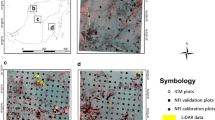Abstract
Forest biomass is an important vegetation attribute for assessing forest ecosystem productivity and function. Estimation of tropical forest biomass has gained importance due to the significance of tropical forests in the global carbon balance. Using remote sensing has been suggested as a potential aboveground biomass (AGB) estimation approach for its spatial coverage and cost effectiveness. Application of such techniques for seasonally dry tropical forests in developing countries is, however, less explored. To this end, the aim of this study is to test the potential of Landsat 8 data for AGB prediction for dry forests in northern Ethiopia. A protected dry Afromontane forest (exclosure), representing a common vegetation type in the region, is selected. The forest is dominated by early successional species, mainly Acacia etbaica. The data necessary for ground-based AGB estimation is collected from 60 circular plots of 200 m2. This study operates with a Landsat 8 image acquired in December 2017, corresponding to the year of vegetation inventory. After correcting the image for sensor, solar, atmospheric, and topographic effects, seven commonly used vegetation indices are derived from the spectral bands. AGB is significantly correlated to all of the Landsat 8 derived spectral variables. One important finding is a linear relationship between AGB, and all of the spectral variables, which allow the development of a linear model using a normalized difference vegetation index (NDVI) as a predictor. The root mean square error of the values predicted using the model is 4 Mg/ha. Finally, the findings allow to conclude that the remotely sensed data have the potential for predicting AGB of seasonally dry forests.
Access this chapter
Tax calculation will be finalised at checkout
Purchases are for personal use only
Similar content being viewed by others
References
Ahamed, T.: A review of remote sensing methods for biomass feedstock production. Biomass Bioenerg. 35, 2455–2469 (2011)
Birhane, E.: Exclosures as forest and landscape restoration tools: lessons from Tigray Region, Ethiopia. Int. for. Rev. 19(4), 37–50 (2017)
Blackie, R., Baldauf, C., Gautier, D.: Tropical dry forests: the state of global knowledge and recommendations for future research. CIFOR (2014)
Brown, S.: Aboveground biomass distribution of US eastern hardwood forests and the use of large trees as an indicator of forest development. For. Ecol. Manage. 96, 37–47 (1997)
Bullock, S.H., Mooney, H.A., Medina, E.: Seasonally Dry Tropical Forests. Cambridge University Press, Cambridge (1995)
Cao, L.: Integrating airborne LiDAR and optical data to estimate forest aboveground biomass in arid and semi-arid regions of China 10, 532 (2018)
Chave, J.: Improved allometric models to estimate the aboveground biomass of tropical trees. Glob. Change Biol. 20, 3177–3190 (2014)
FAO: Global forest resources assessment 2015. Desk reference. Food and Agricultural Organization of the United Nations, Rome (2015)
Gleason, C.J.: A review of remote sensing of forest biomass and biofuel: options for small-area applications. Gisci. Remote Sens. 48, 141–170 (2011)
Goetz, S.: Mapping and monitoring carbon stocks with satellite observations: a comparison of methods. Carbon Balance Manage. 4, 2 (2009)
Joshi, N.: A review of the application of optical and radar remote sensing data fusion to land use mapping and monitoring. Remote Sens. 8, 70 (2016)
Lu, D.: The potential and challenge of remote sensing-based biomass estimation. Int. J. Remote Sens. 27, 1297–1328 (2006)
Lu, D.: A survey of remote sensing-based aboveground biomass estimation methods in forest ecosystems. Int. J. Digit. Earth 9, 63–105 (2016)
Murphy, P.G.: Ecology of tropical dry forest. Annu. Rev. Ecol. Syst. 17, 67–88 (1986)
Seidel, D.: Review of ground-based methods to measure the distribution of biomass in forest canopies. Ann. For. Sci. 68, 225–244 (2011)
Ubuy, M.: Aboveground biomass models for trees and shrubs of exclosures in the drylands of Tigray, northern Ethiopia. J. Arid Environ. 156, 9–18 (2018)
UNFCCC: The Cancun agreements. Outcome of the Work of the Ad Hoc Working Group on Long-term Cooperative Action Under the Convention. Decision 1/CP.16 (2010)
Wang, G.: Uncertainties of mapping aboveground forest carbon due to plot locations using national forest inventory plot and remotely sensed data AU—Wang, Guangxing. Scand. J. for. Res. 26, 360–373 (2011)
Author information
Authors and Affiliations
Corresponding author
Editor information
Editors and Affiliations
Rights and permissions
Copyright information
© 2022 The Author(s), under exclusive license to Springer Nature Switzerland AG
About this paper
Cite this paper
Rannestad, M., Eid, T., Bollandsås, O.M., Gobakken, T., Tetemke, B. (2022). Aboveground Biomass Prediction Model Using Landsat 8 Data: A Test on Possible Approaches for Seasonally Dry Forests of Northern Ethiopia. In: El-Askary, H., Erguler, Z.A., Karakus, M., Chaminé, H.I. (eds) Research Developments in Geotechnics, Geo-Informatics and Remote Sensing. CAJG 2019. Advances in Science, Technology & Innovation. Springer, Cham. https://doi.org/10.1007/978-3-030-72896-0_87
Download citation
DOI: https://doi.org/10.1007/978-3-030-72896-0_87
Published:
Publisher Name: Springer, Cham
Print ISBN: 978-3-030-72895-3
Online ISBN: 978-3-030-72896-0
eBook Packages: Earth and Environmental ScienceEarth and Environmental Science (R0)




